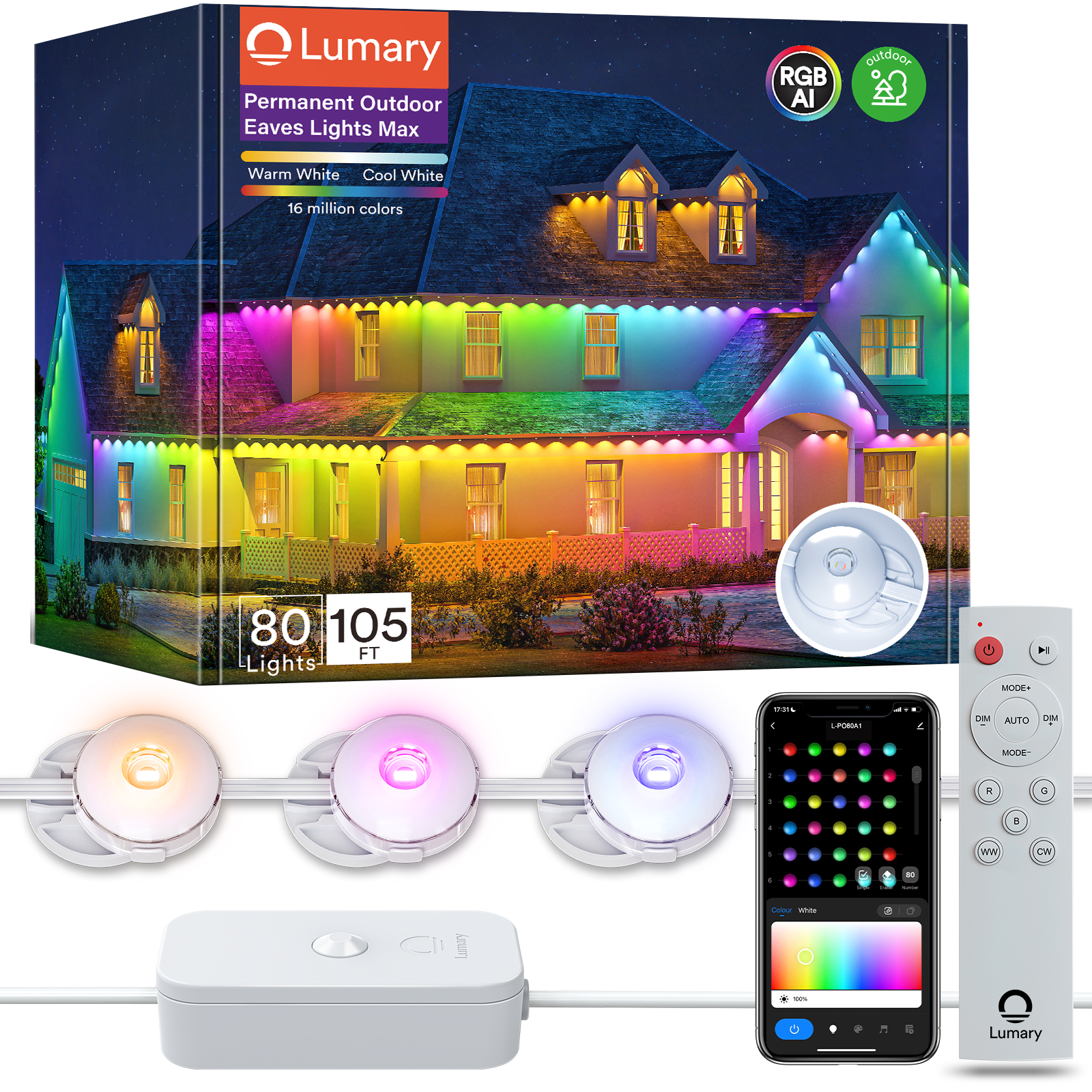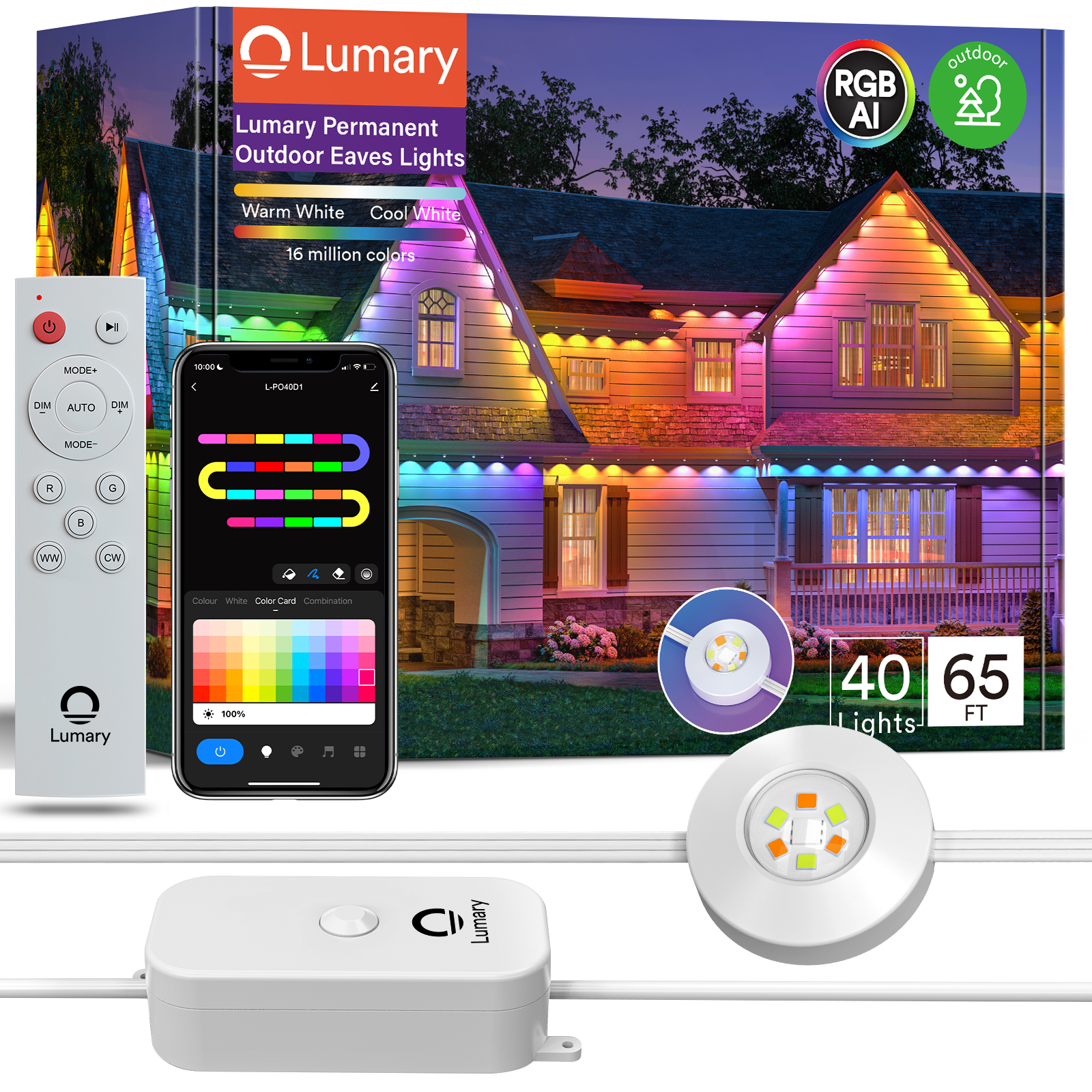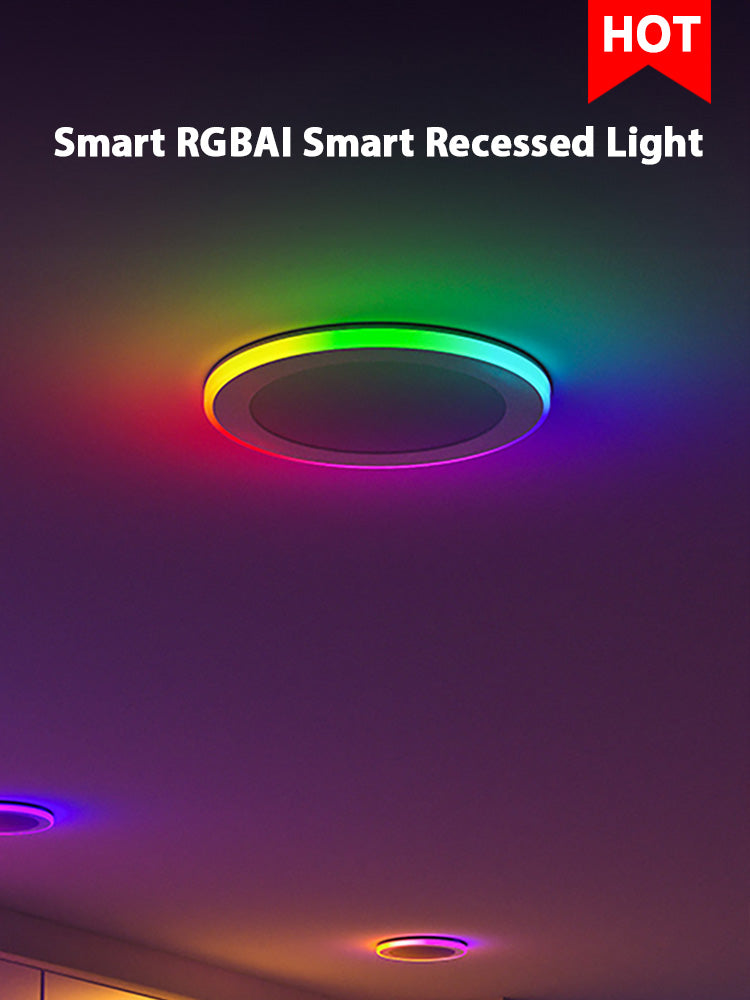Want to choose ceiling fans that fit your space and style? Start by matching the ceiling fan size to your room size, measure your ceiling height, and check the decor. Many people make mistakes like picking a fan too big or too small, ignoring ceiling height, or skipping color samples. Here’s a quick checklist to help you measure for ceiling fans and avoid these pitfalls:
-
Measure your room’s length and width.
-
Measure from the floor to the ceiling.
-
Measure the area where you want to install the fan.
Think about function and aesthetics. Smart, energy-efficient ceiling fans can give you more control and save money. Choosing ceiling fans that match your rooms makes a big difference, whether it’s for bedrooms, patios, or even an outdoor ceiling fan.

Key Takeaways
-
Measure your room’s length, width, and ceiling height to pick the right fan size and ensure safe installation.
-
Choose a fan blade span that fits your room size for efficient airflow and comfort.
-
Match your ceiling fan style and color to your room’s decor to enhance the look and feel of your space.
-
Use the correct mounting type based on ceiling height to keep the fan stable and at the right height.
-
Consider smart features like remote control, scheduling, and energy-saving motors for better comfort and lower bills.
Measure for a Ceiling Fan
Choosing the right ceiling fan size starts with accurate measurements. You want your fan to fit your space, look great, and move air efficiently. Let’s break down how to measure a room for a ceiling fan and make sure you get the perfect fit.
Room Size and Ceiling Fan Size
First, you need to measure your room. Grab a tape measure and follow these steps:
-
Measure the length of your room from one wall to the opposite wall.
-
Measure the width by going from one side to the other.
-
Multiply the length by the width to get the square footage of the room.
-
For L-shaped or odd-shaped rooms, split the space into rectangles, measure each, and add them together.
-
Measure the ceiling height from the floor to the ceiling.
Once you have the square footage of the room, you can use a ceiling fan size guide to pick the right fan. Here’s a quick table to help you size the fan to your room:
|
Room Size (sq ft) |
Recommended Blade Span (inches) |
Best For |
|---|---|---|
|
Up to 75 |
29 to 36 |
Small rooms, bathrooms, offices |
|
76 to 144 |
36 to 42 |
Bedrooms, kitchens |
|
145 to 225 |
44 to 50 |
Living rooms, dining rooms |
|
226 to 400 |
50 to 60 |
Large bedrooms, family rooms |
|
Over 400 |
60 or larger, or multiple fans |
Great rooms, open spaces |
For rooms between 175 and 350 square feet, a 52-inch fan is ideal. This size works well for large bedrooms, family rooms, or media rooms. If you have a bigger space, you might need a larger fan or even more than one fan to keep air circulation strong.
Tip: Always measure the blade span from the tip of one blade straight across to the tip of the opposite blade. This helps you pick the right ceiling fan size for your space.
When you measure a room for a ceiling fan, remember to check the clearance. Make sure there’s at least 30 inches between the fan blades and the nearest wall or furniture. This keeps the air moving and prevents the fan from wobbling.
Ceiling Height and Mounting
Now, let’s determine the height of a ceiling fan for your room. The way you mount your fan depends on how high your ceiling is. Here’s a table to help you choose the right mounting type:
|
Ceiling Height (ft) |
Mounting Type |
Details |
|---|---|---|
|
Under 8 |
Flush-mount (hugger) |
Fan sits close to ceiling for safety |
|
8 to 9 |
Standard mount with short downrod (3-5 in) |
Keeps blades 8-9 feet above floor |
|
10 or higher |
Extended downrod |
Lowers fan to right height for airflow |
|
Vaulted/sloped |
Angled downrod or adapter |
Keeps fan stable and level |
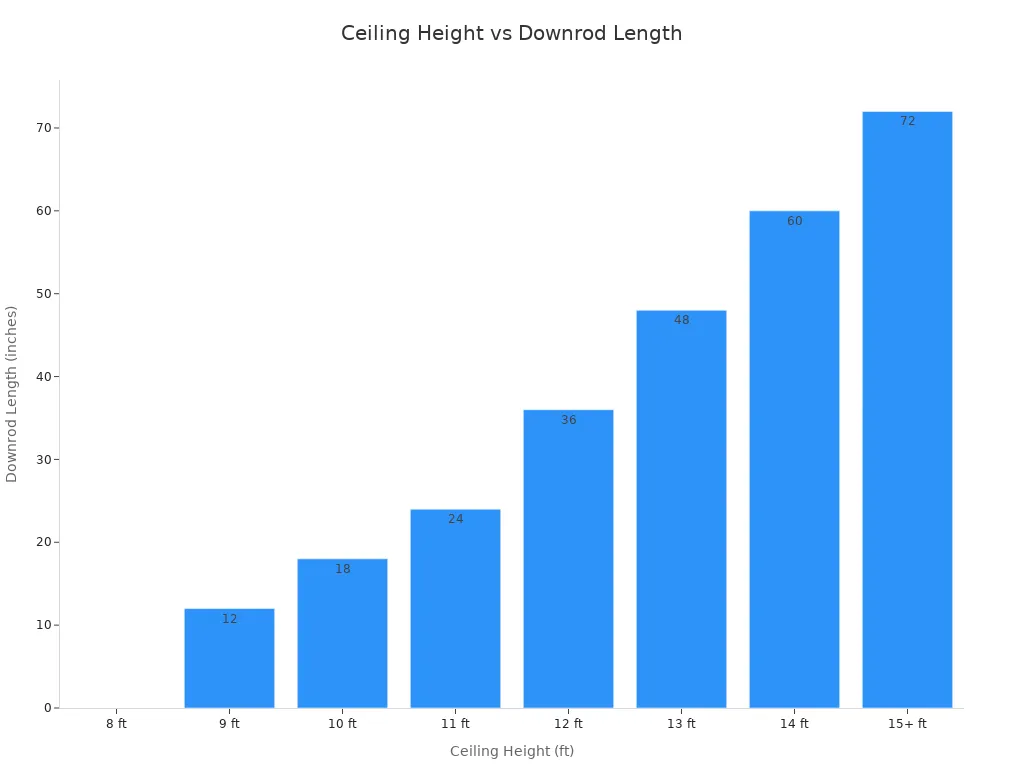
You want the bottom of the fan to hang at least 7 feet above the floor. This is the minimum for safety. For the best air circulation, try to keep the blades between 8 and 9 feet above the floor. If your ceiling is low, use a flush-mount fan. For high ceilings, use a downrod to bring the fan down to the right height.
When you measure for a ceiling fan, don’t forget these safety clearances:
-
Fan blades must be at least 7 feet above the floor.
-
Keep at least 30 inches between blade tips and walls or large furniture.
-
Stay at least 3 feet away from smoke alarms and fire sprinklers.
-
Use a fan rated for the room’s environment (dry, damp, or wet) if you need an outdoor ceiling fan.
If you have a sloped or vaulted ceiling, measure the angle and use a special adapter or angled downrod. This keeps the fan level and stable.
Note: For large or open rooms, you might need more than one fan to keep the whole space comfortable.
When you measure a room for a ceiling fan, you make sure the fan is appropriate for your room size and ceiling height. This helps you get the best performance and safety from your residential ceiling fans, whether you’re installing them in bedrooms, kitchens, or even outdoors.

Choose a Ceiling Fan Style
Matching Fan Style to Decor
Picking the right ceiling fan style can make your room look amazing. You want your fan to blend in or stand out, depending on your taste. Start by looking at your room’s colors, shapes, and materials. Think about what you already have—your furniture, rugs, and wall art. This helps you choose a fan that fits in, not one that looks out of place.
Here are some ceiling fan styling tips to help you match your fan to your decor:
-
Use the 60/30/10 color rule. Sixty percent of your room should be the main color, thirty percent a secondary color, and ten percent an accent. Your fan can be that accent color for a pop of style.
-
Match the fan’s finish to other fixtures in your room, like lamps or cabinet handles.
-
Choose a fan with a shape or blade style that fits your room’s vibe. Sleek, straight blades look modern. Curved or wood blades feel rustic or cozy.
-
Decide if you want your fan to blend in with the ceiling or stand out as a statement piece.
Many types of ceiling fans are trending right now. Minimalist fans with clean lines and fewer blades look great in modern spaces. Fans with wood blades or mixed materials add warmth and texture, perfect for rustic or farmhouse rooms. Some fans even combine metal and wood for a cool, mixed-media look. If you want something bold, try a fan with a matte black or brushed nickel finish.
Check out this table to see how different ceiling fan styles fit with different room types:
|
Ceiling Fan Style |
Key Characteristics |
Suitable Room Aesthetics |
Example Features |
|---|---|---|---|
|
Modern |
Sleek, minimal, soft brass or brushed nickel |
Contemporary, modern homes |
LED light, smart controls, 3 blades |
|
Rustic |
Wood blades, warm finishes like bronze or teak |
Cabins, farmhouse, cozy spaces |
Metal accents, natural wood textures |
|
Industrial |
Rugged metal, exposed hardware, matte black |
Industrial, urban, lofts |
Mesh cage, robust construction |
|
Transitional |
Mix of traditional and modern, neutral colors |
Versatile, mixed interiors |
Reversible blades, remote control |
You can see that each ceiling fan style brings a different mood to your space. Modern fans work well in new homes or apartments. Rustic fans add charm to country or farmhouse rooms. Industrial fans fit lofts or city apartments. Transitional fans are great if you like a mix of old and new.
Tip: Before you buy, look at your room’s style and decide if you want your fan to blend in or stand out. This makes it easier to pick a fan that will suit your style.
Color and Finish Options
The color and finish of your ceiling fan can change the whole feel of your room. Some colors make a fan blend in, while others make it pop. Here are some of the most popular options:
-
White: Clean and classic. White fans work in almost any room and blend with light ceilings.
-
Black: Bold and modern. Black fans make a statement and look great in both modern and industrial rooms.
-
Brushed Nickel: Sleek and shiny. This finish matches many kitchen and bathroom fixtures.
-
Bronze: Warm and rich. Bronze fans add a cozy touch to rustic or traditional spaces.
-
Wood: Natural and inviting. Wood blades bring warmth and texture, perfect for farmhouse or coastal rooms.
-
Chrome or Gold: Shiny and fancy. These finishes add a touch of luxury to bedrooms or living rooms.
Some fans have reversible blades, so you can change the look whenever you want. You might have a dark wood finish on one side and a lighter color on the other. This gives you more ways to match your fan to your decor.
Here’s a quick guide to how different colors and materials fit with room styles:
|
Fan Color/Material |
Effect on Room Aesthetic |
Best For Room Styles |
|---|---|---|
|
Wood |
Adds warmth and texture |
Rustic, farmhouse, coastal |
|
Gold |
Feels luxurious and glamorous |
Luxury, vintage |
|
Gray |
Modern and sophisticated |
Modern, minimalist, urban |
|
Black |
Versatile and bold |
Modern, industrial, many types |
|
White |
Clean and classic |
Traditional, minimalist |
Modern ceiling fans do more than just look good. Many types now have smart features and energy-saving motors. Some fans come with advanced lighting, like RGBAI technology. This lighting lets you pick from millions of colors, set the mood, and even sync the lights to music. You can control these fans with your phone or voice, making it easy to change the speed or color for any occasion.
Ceiling fan styling tips: Try matching your fan’s finish to your room’s hardware for a unified look. Or, use a fan with colorful lighting to create a fun, unique atmosphere. With so many types and finishes, you can always find a ceiling fan style that will suit your style and make your rooms feel just right.

Ceiling Fans Features and Performance
Lighting and Controls
Modern ceiling fans do more than just move air. You can now control them in many ways. Use a remote, a wall switch, or even your smartphone. Some types let you use voice commands with smart home systems. Imagine saying, “Turn on the fan,” and it just works! Many fans also let you set schedules. You can program them to turn on before you get home or off when you leave. This helps save energy and keeps your space comfortable.
Lighting has become a big part of ceiling fans. Many models come with LED lights that you can dim or change color. Some even let you pick from millions of colors to match your mood or event. You can create a cozy reading nook or a fun party vibe with just a few taps on your phone. These smart features make it easy to set the perfect scene for any room.
Tip: Try using the scheduling feature to have your fan and lights turn on and off automatically. This can help you save money and make your home feel more welcoming.
Airflow and Energy Efficiency
When you pick a ceiling fan, you want strong air circulation and low noise. The best fans use advanced motors that run quietly, so you can sleep or work without distractions. Quiet operation is great for bedrooms, offices, and even nurseries.
Airflow is measured in CFM (cubic feet per minute). Larger fans usually move more air. Check out this chart to see how fan size affects airflow:
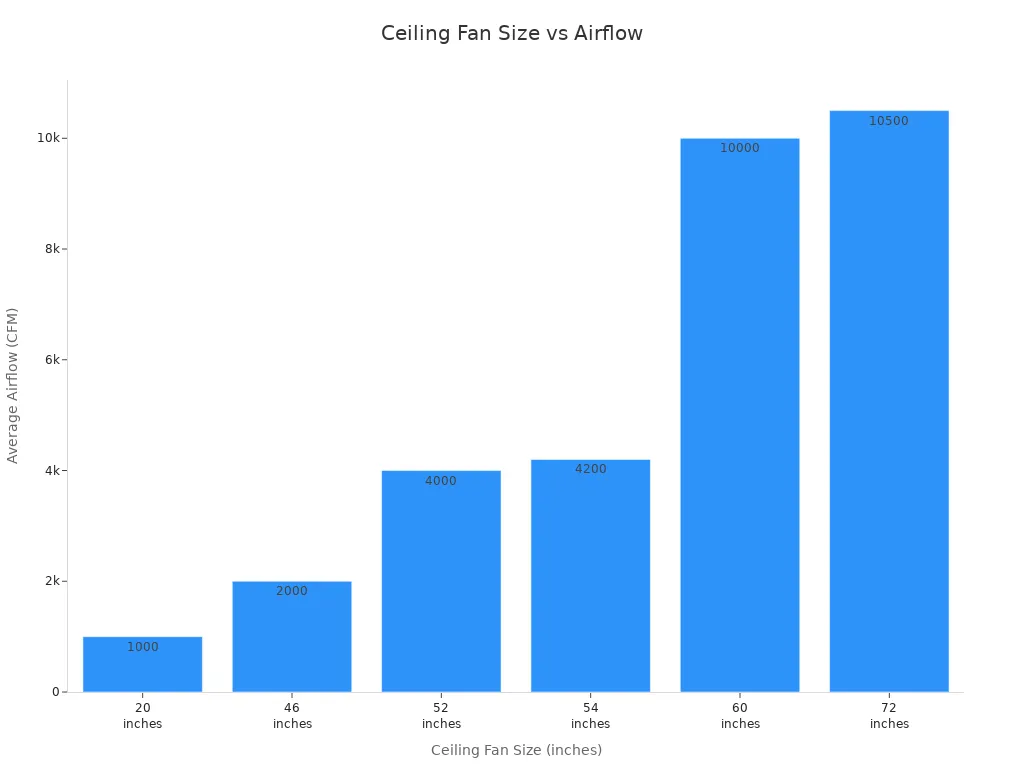
You want optimal airflow for your room size. A 52-inch fan can deliver about 4000 CFM, which is great for most living rooms and bedrooms. The airflow and blade shape also matter. Some fans use special blades to boost indoor air circulation and keep you cool.
Energy efficiency is another key feature. Newer fans use less electricity than older models. Many energy efficient fans use advanced motors and LED lights. This means you get strong air circulation and optimal airflow while saving on your power bill. Some fans even have reversible motors. In summer, they push cool air down. In winter, they pull warm air up from the ceiling, helping you stay comfortable all year.
Did you know? Setting schedules and using reversible motors can cut your energy use by up to 30%. That’s good for your wallet and the planet!

How to Choose a Ceiling Fan
Step-by-Step Checklist
Ready to choose a ceiling fan for your space? Use this simple checklist to make sure you get the best fit for your rooms:
-
Measure the length and width of your room to find the square footage.
-
Pick a fan blade span that matches your room size. For example, larger rooms need bigger fans.
-
Measure the ceiling height. Make sure the fan blades will hang at least 7 feet above the floor.
-
Use a downrod if your ceiling is higher than 8 feet. This helps the fan work better.
-
Check that the fan will be at least 18-24 inches from walls and 10-12 inches from the ceiling.
-
Place the fan in the center of the room for even airflow. For big or oddly shaped rooms, you might need more than one fan.
-
Choose a fan that is rated for your room’s environment, like damp-rated fans for covered patios.
-
Think about features you want, such as forward and reverse operation for year-round comfort, or smart controls for easy adjustments.
Tip: Always measure before you buy. This helps you choose the right ceiling fan and avoid returns.
Common Mistakes to Avoid
When you choose a ceiling fan, watch out for these common mistakes:
-
Forgetting to measure your room or ceiling height, which can lead to poor airflow.
-
Picking a fan that is too big or too small for your space.
-
Ignoring the type of room—indoor fans don’t work well outside.
-
Overlooking energy-efficient fans, which can save you money on your bills.
-
Skipping the instructions during installation, which can cause safety issues.
-
Not checking if your electrical box can support a ceiling fan.
-
Mounting the fan at the wrong height, which affects how well it works.
-
Not balancing the blades, which can make the fan wobble or get noisy.
Choosing a ceiling fan with smart features can make your life easier. You can control the fan with your phone or voice, set schedules, and even track energy use. These features help you stay comfortable and save energy at the same time.
Choosing the perfect ceiling fan is easy when you follow a few key steps:
-
Measure your room and ceiling height for the right fit and safe installation.
-
Pick a fan size and style that matches your space and decor.
-
Use a checklist to cover airflow, lighting, and control options.
-
Explore smart features for better comfort and energy savings.
Accurate measurements help your fan work well and look great. Try these tips and enjoy a cooler, more stylish home. Ready to upgrade? Start by measuring your space today!
FAQ
How do I know what size ceiling fan I need?
Measure your room’s length and width. Multiply them to get square footage. Use a fan size chart to match the blade span to your room. For most bedrooms or living rooms, a 52-inch fan works well.
Can I install a ceiling fan on a sloped ceiling?
Yes, you can. Use an angled mounting kit or a special downrod. This keeps the fan level and stable. Always check the angle before you buy the mounting hardware.
What is the best height to hang a ceiling fan?
Hang your fan so the blades are at least 7 feet above the floor. For better airflow, try to keep them between 8 and 9 feet high. Use a downrod if your ceiling is tall.
Do ceiling fans help in winter?
Yes! Reverse the fan direction so it spins clockwise. This pushes warm air down from the ceiling. You stay warmer and may save on heating costs.
Can I control my ceiling fan with my phone or voice?
Many modern fans offer smart controls. You can use an app or voice assistant to change speed, lighting, or set schedules. Check if your fan supports these features before you buy.







